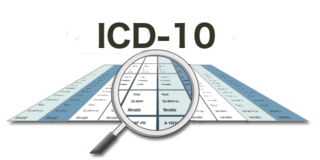The International Classification of Diseases (ICD) is a globally used diagnostic tool for epidemiology, health management and clinical purposes. The ICD is maintained by the World Health Organization (WHO), which is the directing and coordinating authority for health within the United Nations System. The ICD is originally designed as a health care classification system, providing a system of diagnostic codes for classifying diseases, including nuanced classifications of a wide variety of signs, symptoms, abnormal findings, complaints, social circumstances, and external causes of injury or disease. This system is designed to map health conditions to corresponding generic categories together with specific variations, assigning for these a designated code, up to six characters long. Thus, major categories are designed to include a set of similar diseases.

Surgery is a medical or dental specialty that uses operative manual and instrumental techniques on a person to investigate or treat a pathological condition such as a disease or injury, to help improve bodily function, appearance, or to repair unwanted ruptured areas.
Diagnosis-related group (DRG) is a system to classify hospital cases into one of originally 467 groups, with the last group being "Ungroupable". This system of classification was developed as a collaborative project by Robert B Fetter, PhD, of the Yale School of Management, and John D. Thompson, MPH, of the Yale School of Public Health. The system is also referred to as "the DRGs", and its intent was to identify the "products" that a hospital provides. One example of a "product" is an appendectomy. The system was developed in anticipation of convincing Congress to use it for reimbursement, to replace "cost based" reimbursement that had been used up to that point. DRGs are assigned by a "grouper" program based on ICD diagnoses, procedures, age, sex, discharge status, and the presence of complications or comorbidities. DRGs have been used in the US since 1982 to determine how much Medicare pays the hospital for each "product", since patients within each category are clinically similar and are expected to use the same level of hospital resources. DRGs may be further grouped into Major Diagnostic Categories (MDCs). DRGs are also standard practice for establishing reimbursements for other Medicare related reimbursements such as to home healthcare providers.
Case mix, also casemix and patient mix, is a term used within healthcare as a synonym for cohort; essentially, a case mix groups statistically related patients. An example case mix might be male patients under the age of 50, who present with a myocardial infarction and also undergo emergency coronary artery bypass surgery.
Medical billing is a payment practice within the United States health system. The process involves a healthcare provider obtaining insurance information from a patient, filing a claim, following up on, and appealing claims with health insurance companies in order to receive payment for services rendered; such as testing, treatments, and procedures. The same process is used for most insurance companies, whether they are private companies or government sponsored programs: Medical coding reports what the diagnosis and treatment were, and prices are applied accordingly. Medical billers are encouraged, but not required by law, to become certified by taking an exam such as the CMRS Exam, RHIA Exam, CPB Exam and others. Certification schools are intended to provide a theoretical grounding for students entering the medical billing field. Some community colleges in the United States offer certificates, or even associate degrees, in the field. Those seeking advancement may be cross-trained in medical coding or transcription or auditing, and may earn a bachelor's or graduate degree in medical information science and technology.

A children's hospital is a hospital that offers its services exclusively to infants, children, adolescents, and young adults. In certain special cases, they may also treat adults. The number of children's hospitals proliferated in the 20th century, as pediatric medical and surgical specialties separated from internal medicine and adult surgical specialties.
A medical classification is used to transform descriptions of medical diagnoses or procedures into standardized statistical code in a process known as clinical coding. Diagnosis classifications list diagnosis codes, which are used to track diseases and other health conditions, inclusive of chronic diseases such as diabetes mellitus and heart disease, and infectious diseases such as norovirus, the flu, and athlete's foot. Procedure classifications list procedure code, which are used to capture interventional data. These diagnosis and procedure codes are used by health care providers, government health programs, private health insurance companies, workers' compensation carriers, software developers, and others for a variety of applications in medicine, public health and medical informatics, including:
Medical practice management software (PMS) is a category of healthcare software that deals with the day-to-day operations of a medical practice including veterinarians. Such software frequently allows users to capture patient demographics, schedule appointments, maintain lists of insurance payors, perform billing tasks, and generate reports.

The Agency for Healthcare Research and Quality is one of twelve agencies within the United States Department of Health and Human Services (HHS). The agency is headquartered in North Bethesda, Maryland, a suburb of Washington, D.C.. It was established as the Agency for Health Care Policy and Research (AHCPR) in 1989 as a constituent unit of the Public Health Service (PHS) to enhance the quality, appropriateness, and effectiveness of health care services and access to care by conducting and supporting research, demonstration projects, and evaluations; developing guidelines; and disseminating information on health care services and delivery systems.
The Current Procedural Terminology (CPT) code set is a procedural code set developed by the American Medical Association (AMA). It is maintained by the CPT Editorial Panel. The CPT code set describes medical, surgical, and diagnostic services and is designed to communicate uniform information about medical services and procedures among physicians, coders, patients, accreditation organizations, and payers for administrative, financial, and analytical purposes. New editions are released each October, with CPT 2021 being in use since October 2021. It is available in both a standard edition and a professional edition.
Outpatient surgery, also known as ambulatory surgery, day surgery, day case surgery, or same-day surgery, is surgery that does not require an overnight hospital stay. The term “outpatient” arises from the fact that surgery patients may enter and leave the facility on the same day. The advantages of outpatient surgery over inpatient surgery include greater convenience and reduced costs.
A patient safety organization (PSO) is a group, institution, or association that improves medical care by reducing medical errors. Common functions of patient safety organizations are data collection and analysis, reporting, education, funding, and advocacy.

ICD-10 is the 10th revision of the International Statistical Classification of Diseases and Related Health Problems (ICD), a medical classification list by the World Health Organization (WHO). It contains codes for diseases, signs and symptoms, abnormal findings, complaints, social circumstances, and external causes of injury or diseases. Work on ICD-10 began in 1983, became endorsed by the Forty-third World Health Assembly in 1990, and was first used by member states in 1994. It was replaced by ICD-11 on January 1, 2022.
Inpatient care is the care of patients whose condition requires admission to a hospital. Progress in modern medicine and the advent of comprehensive out-patient clinics ensure that patients are only admitted to a hospital when they are extremely ill or have severe physical trauma.
Health information technology (HIT) is health technology, particularly information technology, applied to health and health care. It supports health information management across computerized systems and the secure exchange of health information between consumers, providers, payers, and quality monitors. Based on an often-cited 2008 report on a small series of studies conducted at four sites that provide ambulatory care – three U.S. medical centers and one in the Netherlands – the use of electronic health records (EHRs) was viewed as the most promising tool for improving the overall quality, safety and efficiency of the health delivery system.

The Veterans Health Information Systems and Technology Architecture (VISTA) is a health information system deployed across all veteran care sites in the United States. VISTA provides clinical, administrative, and financial functions for all of the 1700+ hospitals and clinics of the Veterans Health Administration VISTA consists of 180 clinical, financial, and administrative applications integrated within a single transactional database.

ECRI is an independent nonprofit organization improving the safety, quality, and cost-effectiveness of care across all healthcare settings worldwide.
The Medical Expenditure Panel Survey (MEPS) is a family of surveys intended to provide nationally representative estimates of health expenditure, utilization, payment sources, health status, and health insurance coverage among the noninstitutionalized, nonmilitary population of the United States. This series of government-produced data sets can be used to examine how individuals interact with the medical care system in the United States.
In the United States, the chargemaster, also known as charge master, or charge description master (CDM), is a comprehensive listing of items billable to a hospital patient or a patient's health insurance provider. In practice, it usually contains highly inflated prices at several times that of actual costs to the hospital. The chargemaster typically serves as the starting point for negotiations with patients and health insurance providers of what amount of money will actually be paid to the hospital. It is described as "the central mechanism of the revenue cycle" of a hospital.
Health care quality is a level of value provided by any health care resource, as determined by some measurement. As with quality in other fields, it is an assessment of whether something is good enough and whether it is suitable for its purpose. The goal of health care is to provide medical resources of high quality to all who need them; that is, to ensure good quality of life, cure illnesses when possible, to extend life expectancy, and so on. Researchers use a variety of quality measures to attempt to determine health care quality, including counts of a therapy's reduction or lessening of diseases identified by medical diagnosis, a decrease in the number of risk factors which people have following preventive care, or a survey of health indicators in a population who are accessing certain kinds of care.






